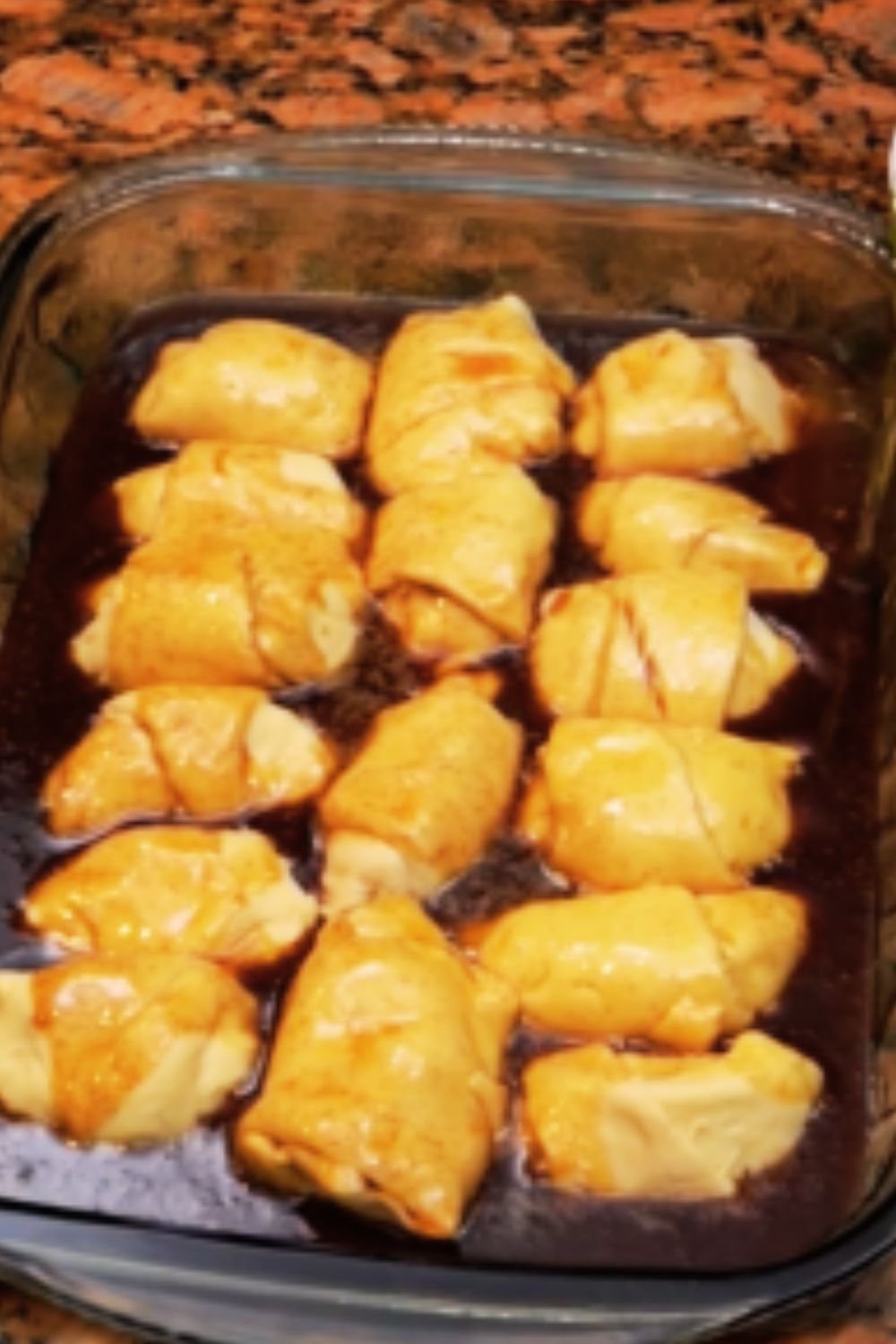There’s something magical about biting into a perfectly made apple turnover. That moment when the flaky pastry shatters between your teeth, revealing the warm, cinnamon-spiced apple filling within—it’s pure bliss. Over my years of baking, I’ve experimented with countless apple turnover recipes, and today I’m thrilled to share my ultimate guide to creating these delectable pastries right in your home kitchen.
Apple turnovers hold a special place in my heart. They remind me of Sunday mornings at my grandmother’s house, where the scent of baking pastry and apples would waft through every room. Though they might seem intimidating at first glance, I promise you that with the right techniques and a bit of patience, you’ll be creating bakery-worthy turnovers in no time.
In this comprehensive guide, I’ll walk you through every step of the process—from selecting the perfect apples to achieving that coveted flaky crust. I’ll share my time-tested recipe, troubleshooting tips, and creative variations to suit any occasion. Whether you’re a seasoned baker or trying your hand at pastry for the first time, this article has something for everyone.
The History of Apple Turnovers
Before we dive into the recipe, let’s take a moment to appreciate the rich history behind these delightful treats. The turnover is believed to have originated in ancient times, with variations appearing in many cultures around the world. The concept is simple yet brilliant: fill a piece of dough with something delicious, fold it over, and bake or fry it.
The apple turnover as we know it today has strong roots in French cuisine, where it’s known as “chausson aux pommes” (apple slippers). These elegant pastries were popularized in the 17th and 18th centuries and eventually made their way across Europe and to America, where they became a beloved staple in bakeries and home kitchens alike.
What makes turnovers so enduring is their perfect balance of simplicity and sophistication. They’re portable, portion-controlled, and versatile—suitable for breakfast, dessert, or an afternoon treat with tea or coffee.
Selecting the Perfect Apples

The foundation of any great apple turnover starts with choosing the right apples. Not all varieties are created equal when it comes to baking. The ideal baking apple should:
- Hold its shape when cooked
- Offer a balance of sweetness and tartness
- Provide enough juice without making the pastry soggy
My top picks for apple turnovers include:
Granny Smith : The classic baking apple. These bright green beauties are quite tart, which provides a wonderful contrast to the sweet pastry. They hold their shape beautifully during baking.
Honeycrisp : My personal favorite for turnovers. They offer the perfect balance of sweetness and acidity, with a firm texture that softens just right in the oven.
Braeburn : These apples have a wonderful complex flavor with notes of spice that complement the cinnamon and nutmeg in the filling.
Golden Delicious : A reliable choice that breaks down a bit more than the others, creating a filling with both chunks and sauce.
Pink Lady : These crisp, sweet-tart apples maintain their shape well and have a lovely rosy hue.
For the best results, I often use a combination of two varieties—typically Granny Smith for structure and tartness, paired with Honeycrisp or Pink Lady for sweetness and complexity. This creates a depth of flavor that elevates your turnovers from good to extraordinary.
The Great Debate: Puff Pastry vs. Pie Crust
When it comes to apple turnovers, there are two main camps regarding the pastry: puff pastry enthusiasts and pie crust devotees. Both have their merits, and I’ve experimented extensively with each.
Puff Pastry
Puff pastry creates turnovers with dramatic height and dozens of delicate, crisp layers. Made through a process of repeatedly folding butter into dough, it puffs up dramatically in the oven as steam gets trapped between the layers.
- Pros: Incredibly light and flaky, impressive appearance, consistent results
- Cons: Time-consuming to make from scratch, can be tricky for beginners
Pie Crust
Pie crust produces turnovers with a more substantial, buttery bite. It’s simpler to make than puff pastry and has a wonderful tender quality.
- Pros: Easier to make from scratch, rich buttery flavor, sturdier structure
- Cons: Less dramatic rise, fewer distinct layers
While I appreciate both styles, my recipe uses puff pastry for that show-stopping flakiness and impressive rise. Don’t worry—I’ll include tips for both homemade and store-bought options to suit your time constraints and comfort level.
Essential Equipment
Before we begin, let’s make sure you have everything you need. The good news is that apple turnovers don’t require any specialized equipment:
- Rolling pin
- Baking sheet(s)
- Parchment paper
- Pastry brush
- Sharp knife or pizza cutter
- Mixing bowls
- Measuring cups and spoons
- Fork (for crimping edges)
- Cooling rack
Having these items ready before you start will make the process much smoother and more enjoyable.
The Ultimate Apple Turnover Recipe
Now, let’s get to the main event—my tried-and-true recipe for perfect apple turnovers. This recipe yields 8 generous turnovers, though you can easily scale it up or down as needed.
Ingredients
For the filling:
- 4 medium apples (about 2 pounds), preferably 2 Granny Smith and 2 Honeycrisp
- 3 tablespoons unsalted butter
- ½ cup granulated sugar
- 2 tablespoons light brown sugar, packed
- 1 tablespoon fresh lemon juice
- 1½ teaspoons ground cinnamon
- ¼ teaspoon ground nutmeg
- ⅛ teaspoon ground allspice
- ¼ teaspoon salt
- 1 tablespoon cornstarch
- 1 teaspoon vanilla extract
For the pastry:
- 2 packages (17.3 oz each) frozen puff pastry sheets, thawed in refrigerator (or homemade puff pastry)
- 1 large egg
- 1 tablespoon water
- Turbinado sugar or granulated sugar for sprinkling
For the optional glaze:
- 1 cup powdered sugar
- 2-3 tablespoons milk or cream
- ½ teaspoon vanilla extract
Instructions
Step 1: Prepare the Apple Filling
- Peel, core, and dice the apples into ½-inch cubes.
- In a large skillet over medium heat, melt the butter.
- Add the diced apples, both sugars, lemon juice, cinnamon, nutmeg, allspice, and salt.
- Cook for about 5-7 minutes, stirring occasionally, until the apples begin to soften but still hold their shape.
- In a small bowl, mix the cornstarch with 1 tablespoon of water to create a slurry.
- Pour the cornstarch slurry into the apple mixture and cook for an additional 1-2 minutes, until the mixture thickens slightly.
- Remove from heat and stir in vanilla extract.
- Transfer to a bowl and refrigerate until completely cooled (at least 30 minutes, or overnight).
Step 2: Prepare the Pastry
- Remove one sheet of puff pastry from the refrigerator (keep the other chilled until ready to use).
- On a lightly floured surface, roll the pastry to a 12×12-inch square.
- Cut the pastry into four equal squares (6×6 inches each).
- Whisk together the egg and water to create an egg wash.
Step 3: Assemble the Turnovers
- Preheat your oven to 400°F (200°C). Line two baking sheets with parchment paper.
- Place about 2-3 tablespoons of cooled apple filling onto the center of each pastry square.
- Brush the edges of the pastry with egg wash.
- Fold the pastry diagonally over the filling to create a triangle.
- Press the edges firmly with your fingers, then crimp with a fork to seal.
- Transfer to the prepared baking sheet and repeat with remaining pastry and filling.
- Cut 2-3 small slits on top of each turnover to allow steam to escape.
- Brush the tops with egg wash and sprinkle generously with sugar.
Step 4: Bake
- Bake in the preheated oven for 20-25 minutes, until puffed and golden brown.
- Rotate the baking sheets halfway through to ensure even browning.
- Allow to cool on the baking sheets for 5 minutes, then transfer to a wire rack.
Step 5: Optional Glaze
- While the turnovers are cooling, whisk together the powdered sugar, milk, and vanilla extract until smooth.
- Drizzle over the warm turnovers.
- Allow the glaze to set before serving.
Make-Ahead and Storage Tips
Apple turnovers are wonderfully versatile when it comes to preparation and storage:
- Filling: The apple filling can be made up to 3 days ahead and stored in an airtight container in the refrigerator.
- Assembled (unbaked): Assembled turnovers can be frozen for up to 1 month. Freeze them on a baking sheet until solid, then transfer to a freezer bag. Bake directly from frozen, adding 5-7 minutes to the baking time.
- Baked: Baked turnovers keep well at room temperature for 2 days or in the refrigerator for up to 5 days. Reheat in a 300°F oven for about 10 minutes to restore crispness.
Homemade Puff Pastry: For the Ambitious Baker

While store-bought puff pastry yields excellent results, there’s something deeply satisfying about creating your own from scratch. It’s a labor of love that takes time but rewards you with unparalleled flavor and bragging rights. Here’s my recipe for those who want to take the plunge:
Ingredients for Homemade Puff Pastry
- 3 cups (375g) all-purpose flour
- 1½ teaspoons salt
- 1 tablespoon granulated sugar
- 1 cup (230g) cold unsalted butter, cut into ½-inch cubes
- 1 tablespoon white vinegar
- ¾ to 1 cup ice water
- 1 cup (230g) cold unsalted butter for the butter block
Method
- In a large bowl, whisk together the flour, salt, and sugar.
- Add the cubed butter and use your fingers to quickly work it into the flour until you have pea-sized pieces.
- Mix the vinegar with ¾ cup of ice water and drizzle over the flour mixture.
- Using a fork, gently toss until the dough starts to come together. Add more water if needed, but be careful not to overwork the dough.
- Turn the dough onto a floured surface and shape it into a rough rectangle. Wrap in plastic and refrigerate for at least 30 minutes.
- For the butter block, place the additional cup of butter between two sheets of parchment paper. Use a rolling pin to flatten it into a 6×9-inch rectangle. Refrigerate until firm.
- Roll the chilled dough into a rectangle twice the size of your butter block.
- Place the butter block on one half of the dough, then fold the other half over it, sealing the edges.
- Roll the dough into a 10×20-inch rectangle, then fold it in thirds like a letter. This completes your first “turn.”
- Rotate the dough 90 degrees, roll it out again, and fold in thirds. This is your second turn.
- Wrap the dough and refrigerate for at least 1 hour.
- Repeat steps 9-11 two more times for a total of six turns, chilling between each set of two turns.
- After the final turn, wrap the dough well and refrigerate for at least 4 hours, or overnight, before using.
This process creates hundreds of layers of butter and dough that will puff up dramatically in the oven. While it’s certainly more time-intensive than using store-bought pastry, the results are truly spectacular.
Variations to Keep Things Interesting
Once you’ve mastered the basic apple turnover, try these delicious variations:
Apple-Cranberry Turnovers
Add ½ cup dried cranberries to the apple filling for a tart pop of flavor and beautiful color contrast.
Caramel Apple Turnovers
Drizzle 2 tablespoons of caramel sauce into each turnover before sealing, or replace the simple glaze with caramel glaze.
Apple-Cheddar Turnovers
Add ¼ cup shredded sharp cheddar cheese to the filling for a savory-sweet combination that’s particularly popular in New England.
Spiced Apple Turnovers
Double the cinnamon and add ¼ teaspoon of cardamom and a pinch of cloves for a warming, chai-inspired flavor profile.
Mini Turnovers
Cut the pastry into smaller squares (about 3×3 inches) to create bite-sized treats perfect for parties or afternoon tea.
Serving Suggestions

While apple turnovers are absolutely delicious on their own, here are some wonderful ways to elevate them for serving:
- Warm turnover with a scoop of vanilla ice cream
- Drizzled with salted caramel sauce
- With a dollop of freshly whipped cream
- Alongside a sharp cheddar cheese slice
- With a steaming cup of chai tea or coffee
- Dusted with powdered sugar and cinnamon
- With a side of warm vanilla custard sauce
For a special breakfast treat, I love serving warm apple turnovers with a side of Greek yogurt drizzled with honey—the tangy yogurt perfectly balances the sweet pastry.
Troubleshooting Common Issues
Even experienced bakers encounter challenges. Here are solutions to the most common apple turnover problems:
Leaking Filling
- Problem: Filling escapes during baking, creating a mess
- Solution: Ensure edges are thoroughly sealed with egg wash and fork crimping. Don’t overfill your turnovers, and make sure your filling isn’t too wet.
Soggy Bottom
- Problem: The bottom of the turnover is undercooked or soggy
- Solution: Make sure your filling has cooled completely before assembling. Drain excess liquid from the filling if necessary. Consider blind-baking the bottom for 5 minutes before adding filling.
Pale Pastry
- Problem: Pastry doesn’t achieve a golden-brown color
- Solution: Ensure you’re brushing thoroughly with egg wash. Bake on a lower rack in your oven, and consider increasing the temperature slightly.
Tough Pastry
- Problem: Pastry is chewy rather than flaky
- Solution: Avoid overworking the dough. Keep ingredients cold throughout the process, and let the dough rest as directed.
Filling Too Runny
- Problem: Apple filling is watery after baking
- Solution: Make sure you’re cooking the filling until it thickens properly. The cornstarch should help with this, but you can increase it to 1½ tablespoons if needed.
Nutritional Information
For those who are nutrition-conscious or need to accommodate dietary restrictions, here’s a breakdown of the approximate nutritional content per turnover (based on the standard recipe without optional glaze):
| Nutrient | Amount per Turnover |
|---|---|
| Calories | 320 |
| Total Fat | 18g |
| Saturated Fat | 7g |
| Cholesterol | 30mg |
| Sodium | 240mg |
| Total Carbohydrates | 36g |
| Dietary Fiber | 2g |
| Sugars | 16g |
| Protein | 4g |
Please note that these values are approximate and can vary based on exact ingredients and portion sizes.
Dietary Adaptations
With a few adjustments, you can adapt this recipe for different dietary needs:
Gluten-Free Apple Turnovers
Replace the traditional puff pastry with gluten-free puff pastry (available at many specialty stores) or make a gluten-free pie crust using a 1:1 gluten-free flour blend.
Vegan Apple Turnovers
Use plant-based puff pastry (many store-bought brands are accidentally vegan), replace butter in the filling with coconut oil or vegan butter, and use plant milk mixed with a little maple syrup for the wash instead of egg.
Reduced-Sugar Apple Turnovers
Decrease the sugar in the filling by up to half and rely on naturally sweet apples like Fuji or Honeycrisp. Skip the glaze and optional sprinkling of sugar on top.
Nut-Free Apple Turnovers
The standard recipe is nut-free, but if you want to add texture, consider using sunflower seeds instead of nuts in any variations.
Q&A Section
Q: Can I use canned apple pie filling instead of making my own?
While you can use canned filling in a pinch, I strongly recommend making your own. Homemade filling has superior flavor and texture, and you can control the sweetness and spice levels. If you must use canned, drain excess liquid and add fresh lemon juice and additional spices to brighten the flavor.
Q: My puff pastry got too warm and sticky. What should I do?
Puff pastry needs to stay cold to work properly. If it becomes too warm or sticky, immediately transfer it to the refrigerator for 15-20 minutes until it firms up again. Always work with one sheet at a time, keeping the others refrigerated until needed.
Q: How do I know when my apple turnovers are done baking?
Look for three signs: 1) The pastry should be puffed and golden brown, 2) You may see bubbling from the vents you cut, and 3) The bottom should look golden and feel firm when gently lifted with a spatula. If in doubt, it’s better to bake an extra minute or two than to underbake.
Q: Can I make these without refined sugar?
Yes! You can substitute the granulated sugar with coconut sugar (which will give a deeper, more caramel-like flavor) or maple sugar. For the filling, you can use honey or maple syrup, though you may need to cook the filling slightly longer to evaporate the extra moisture.
Q: My turnovers didn’t puff up as much as expected. What went wrong?
Several factors can affect puffing: 1) The pastry may have gotten too warm before baking, 2) The edges might not have been cut cleanly (which can prevent layers from rising), 3) Your oven temperature might be off, or 4) The pastry might have been overworked. Remember that homemade puff pastry generally doesn’t rise quite as dramatically as commercial versions, which are often made with special equipment.
Q: How far in advance can I make these for a party?
For the best quality, I recommend baking turnovers the same day you plan to serve them. However, you can prepare the filling and even assemble the unbaked turnovers a day ahead (keep refrigerated). Alternatively, bake them a day ahead and refresh in a 300°F oven for 5-10 minutes before serving to restore crispness.
Final Thoughts
There’s something truly special about the process of creating apple turnovers from scratch. It connects us to culinary traditions that span centuries and continents, while also giving us the freedom to add our own personal touches. Whether you’re making these as a weekend project, for a special breakfast, or as the finale to a dinner party, the care you put into each step will be evident in every flaky, apple-filled bite.
I hope this guide has demystified the process and inspired you to try your hand at these classic pastries. Remember that practice makes perfect, and even imperfect turnovers are usually delicious! Start with the basic recipe, then feel free to experiment with different apple varieties, spice combinations, and serving styles to make these turnovers truly your own.
Happy baking!


